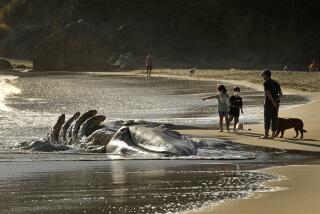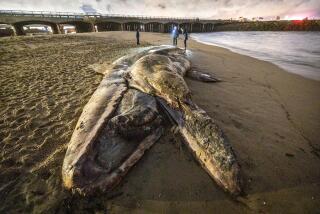Rescuers Seek to Win Whales’ Trust
BARROW, Alaska — Rescue workers believe they have convinced three trapped California gray whales to trust them enough to leave their safe haven and move on to newly created holes in the Arctic ice, increasing the chances that the whales can eventually be led to freedom.
But it took an Eskimo whaling captain to find a way.
The best chance for freeing the whales lies in creating a series of additional holes-- possibly with a huge chunk of concrete that will be repeatedly dropped into the ice by cable from an Alaska National Guard helicopter.
Fear Whales Will Stay
But biologists had feared that the frightened and tired whales would refuse to leave the area where they have managed to survive.
Early Thursday morning workers completed a new hole and tried to get the whales to move over. Ron Morris, a marine biologist with the National Oceanic and Atmospheric Administration, who is coordinating the effort, said the whales initially went to the new hole, apparently attracted by the humming noise of a small de-icing machine, but quickly returned to their original refuge and refused to leave.
Finally, Arnold Brower Jr., a member of a prominent whaling family here, reached out in the blackness of the night and touched one of the whales with a stick.
The startled whale swam instantly to the new hole, followed by the two others. This time, all three stayed, huddled around the de-icer with its soothing hum.
Biologists now hope to condition the whales to associate the hum with open water. Then, they might move quickly to new holes that are to be broken open between the whales and an open area in the ice about four miles away.
Rescue teams, working around the clock, got a little encouragement Friday from the National Weather Service. Generally favorable weather, with winds out of the east that are holding the Arctic ice field off from the newly formed ice along the shore, was expected to continue at least through the weekend.
Crews Practice Breaking Ice
By early Friday evening, the National Guard was to begin the effort to break through the ice with the 10,000-pound lump of concrete. Col. Tom Carroll said the block of concrete has a sharp point and is one of three of varying sizes that crews had practiced with in nearby ice fields.
There is still a slim chance that an icebreaking barge can be towed here by helicopter from the Prudhoe Bay oil fields, but National Guardsmen who have worked for the past week to make that happen were thinking of abandoning that plan, Carroll said. It has turned out to be more difficult than anyone had imagined to tow the barge over the ice.
More to Read
Sign up for Essential California
The most important California stories and recommendations in your inbox every morning.
You may occasionally receive promotional content from the Los Angeles Times.









